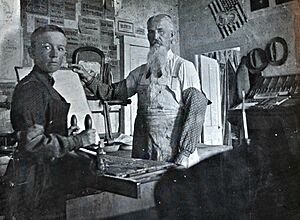Delamar, Nevada facts for kids
Quick facts for kids
Delamar, Nevada
|
|
|---|---|
 |
|
| Country | United States |
| State | Nevada |
| County | Lincoln |
| Time zone | UTC-8 (Pacific (PST)) |
| • Summer (DST) | UTC-7 (PDT) |
| Official name | Delamar "The Widow Maker" (1893-1909) |
| Reference no. | 90 |
Delamar, Nevada, often called The Widowmaker, is a famous ghost town in the eastern part of Nevada, USA. It sits along the east side of the Delamar Valley. This town was once a very busy place, especially between 1895 and 1900. During that time, it produced a huge amount of gold – about $13.5 million worth!
Contents
History of Delamar
In 1889, two gold seekers named John Ferguson and Joseph Sharp found gold near a place called Monkeywrench Wash. They set up a small mining camp, or settlement, west of the Monkeywrench Mine. This first camp was called Ferguson.
In April 1894, a man named Captain Joseph Raphael De Lamar bought most of the important mines in the area. He then renamed the Ferguson camp to Delamar. In the same year, a local newspaper called the Delamar Lode started printing. A post office also opened, making it easier for people to send and receive mail.
Delamar's Gold Rush Days
From 1895 to 1900, Delamar was the top gold-producing town in all of Nevada. By 1897, the new town had grown very quickly. More than 3,000 people lived there! Delamar had many important buildings and services for its residents.
The town had a hospital to care for the sick and injured. There was also an opera house for entertainment, several churches, and a school for children. Many businesses and saloons also opened. Most of the buildings were made from strong local rock.
By 1896, the Delamar mill was very busy. It could process up to 260 tons of gold ore every single day. Water for the town was pumped from a well located about twelve miles away in Meadow Valley Wash. Supplies and materials had to travel even further. Mule teams carried them over mountains from the railroad in Milford, Utah, which was 150 miles from Delamar.
The Decline of Delamar
The town faced a big challenge in the spring of 1900. A large fire almost completely destroyed Delamar. In 1902, Captain De Lamar sold his mines. By then, his mines had produced about $8.5 million in gold.
The new owners of the mines installed a bigger, more modern mill in 1903. This new mill could process 400 tons of ore daily. However, the mine eventually stopped operating in 1909.
There was a brief attempt to bring the town back to life between 1929 and 1934. The post office reopened in March 1933, and the school also started again. But this revival didn't last long. The post office closed for good in February 1941.
What Remains of Delamar Today?
Today, there are only a few things left to remind us of the once-busy town of Delamar. Many stone ruins still stand, partly intact, in the area. You can easily see the foundations of old mining buildings from the nearby hills.
There are also two old graveyards in the area. Sadly, these graveyards have been damaged over time. The land around Delamar is full of old mines and mine shafts. However, in recent years, the main mine shaft has been closed off for safety.
Wild horses now roam freely in the area where the town once stood. There's also a dry lake nearby that pilots call Texas Lake. This is because its shape looks a lot like the state of Texas from above!
The "Widowmaker" Nickname
The gold in the Delamar mines was found inside a very hard rock called quartzite. When this rock was crushed to get the gold out, it created a very fine dust. Miners who breathed in this dust often developed a serious lung disease called silicosis. This disease made it very hard to breathe and could be deadly. Because of this dangerous condition, the town became known as "The Widowmaker."





